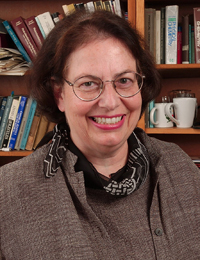The secret life of a molecule
Using spectroscopy, Veronica Vaida, CIRES Fellow and Professor of Chemistry and Biochemistry at the University of Colorado at Boulder, has discovered several reactions in the atmosphere that influence climate, air pollution and the workings of the atmosphere. This year, the American Chemical Society honored her for her contributions with the E. Bright Wilson Award in Spectroscopy.
By Kristin Bjornsen

How would you define optical spectroscopy for a layperson?
It is the interaction of radiation with molecules that lets you glimpse their properties. Basically, you shine light on a molecule and monitor which wavelengths of light are affected. Knowing what wavelengths it absorbs gives the investigator a window into the molecule’s structure and the chemistry of the molecule.
What draws you to this field?
I like the challenge of looking at a molecule 1024 times smaller than our world and unraveling its fundamental properties and how
these play out on the bigger, atmospheric scale.
What were some unexpected discoveries?
We found that red light, such as is available at dusk and dawn, can initiate reactions in many compounds, including sulfuric, nitric and organic acids, which are important in air pollution. Field measurements were seeing a spike in reactive species when the Sun was at the horizon, but models did not contain the chemistry needed to explain these observations. The chemistry we proposed brought a new paradigm for how light can affect the atmosphere.
Another problem we investigated using spectroscopy involved small aggregates of water—two, three, four waters forming a complex—which absorb light differently than a single water molecule. Atmospheric observations highlighted the possibility that some hidden agent was absorbing solar radiation, but they didn’t know what. This discrepancy between
models and observations was termed anomalous cloud absorption, and our work contributed to understanding these effects. An increase in the Earth’s temperature would increase evaporation of water, and the concentration of these water clusters would go up exponentially. As a result, their effect could be even more important in a global warming scenario, providing a nonlinear amplifier to anthropogenically induced climate change.
In 1979, you became Harvard’s first woman assistant professor in chemistry. While there, you were colleagues with E. Bright Wilson, the pioneer of molecular spectroscopy. What was that like?
My office was next door to his, and he was a very good friend and mentor. He advised me on how to think about science, how to go about it, and the right reasons to do it. He remains one of my heroes, which made it especially meaningful for me to get this award.


